Saturday, February 25, 2012
Adding Busuu into my mix of resources
I was recently going through some old email, and found one from Busuu from when I'd signed up for the service. I'd forgotten that I had an account with them, but I'd signed up with them last year when they introduced Turkish as one of their languages being taught. I'm not sure why I never pursued it, but I forgot about Busuu after I'd created my account.
In any case, I decided to give them another look. I'm glad I did. It's proving to be a good addition to my current resources.
They currently offer English, Spanish, French, Italian, Portuguese, Russian, Polish, Turkish, Arabic, Japanese and Chinese as full courses, but you can choose other languages to study, as I'll note later.
I wanted to start at their A2 level course and go from there, but it either wasn't allowed or I wasn't able to figure out how, so I had to go back to the beginner A1 course. It took me about four days to get through the A1 course. It's been a really good refresher, and I picked up some more vocabulary too. I can honestly say it's much more complete than, say, Teach Yourself Turkish, or even FSI. As a non-paying member, I was able to complete 25 lessons from the A1 course, but I think there are 35 lessons in total. The ten lessons that I didn't have access to appear to be mostly grammar-related. That's OK, since A1 is a refresher for me. I've now started on the A2 course. If I were a paying member, I would have access to much more material, including downloadable audio and PDFs of all the lesson material.
I think what probably impresses me most about Busuu though, is the social factor. Sure, there are other sites that offer a social aspect to learning, but I've not seen so much social interaction as I have on Busuu. Lang-8 comes close, but you don't get the camaraderie of shared courses like you do with Busuu. After every single exercise I completed, within seconds I had corrections, encouragement and requests for friendships. The chat and other realtime features are pretty good, and quite useful. I guess I should probably note that Busuu, like any other socially-powered site, has its share of people just looking to hook up. If that's what you're into, fine, but Busuu gives you ways to combat it if you need to, by blocking/reporting as spam, as well as up/down voting in the comments and critiques of your writing exercises.
Knowing that they didn't have any Georgian course, I still specified that I was learning the language. It gave me the option to search for native Georgian speakers and returned pages of users, so that may be an option for lesser spoken language conversation partners.
I can't really comment on the upper lesson levels, since I've just started to use the service in earnest, but if the quality remains as it has with the first course, I'm probably going to spring the €75 for 12 months of premium access.
I highly recommend it as an additional resource!
Wednesday, February 15, 2012
Cooking shows
In my quest to expand my Turkish vocabulary this year, I've started to watch a couple cooking shows on Kanal D, in addition to all the other programming I'm soaking up. One of these is Mutfağim (My kitchen). It's squarely aimed at women, at least that's all I've seen on the show so far, but who cares? I'm learning a lot from it!
I love Turkish food, so any cooking show about Turkish food has my interest. And I also like to cook, even if I'm not the best cook in the world.
I've already learned a few general food items, such as meyve (fruit), sebze (vegetable), ekmek (bread), peynir (cheese), piliç (chicken), etc. But actually cooking a dish takes some other vocabulary that I didn't have. This is where the cooking shows come in. I learned this helpful trick from an Italian teacher I had years ago. She would actually bring in a hotplate to the class and we'd learn how to cook a simple dish, then enjoy the results after class.
So in these shows, I learn all sorts of useful words like karıştırmak (to mix or blend), eklemek (to add in) and beklemek (to let sit). I also learn basic kitchen terms for measurements, such as bardak (a cup), kaşık (a spoonful) and demet (as in demet maydanoz- a bunch/bundle of parley).
Another little trick I learned a while back was to prepare my shopping lists in the target language with no English translation. If, while at the store, I couldn't remember what the word meant, I did without.
You can bet that it only took one trip to the store and forgetting to thoroughly learn words like un (flour), yumurta (egg), sarımsak (garlic) and maya (yeast).
It may not seem like a lot of new words, but each one of those words is useful, and something I can use daily - well, except for maybe yeast.
So, lahmacun, here I come! Once I've successfully made it, I'll post the yapılışı (the directions or preparation) for the lahmacun tarifi (lahmacun recipe).
I love Turkish food, so any cooking show about Turkish food has my interest. And I also like to cook, even if I'm not the best cook in the world.
I've already learned a few general food items, such as meyve (fruit), sebze (vegetable), ekmek (bread), peynir (cheese), piliç (chicken), etc. But actually cooking a dish takes some other vocabulary that I didn't have. This is where the cooking shows come in. I learned this helpful trick from an Italian teacher I had years ago. She would actually bring in a hotplate to the class and we'd learn how to cook a simple dish, then enjoy the results after class.
So in these shows, I learn all sorts of useful words like karıştırmak (to mix or blend), eklemek (to add in) and beklemek (to let sit). I also learn basic kitchen terms for measurements, such as bardak (a cup), kaşık (a spoonful) and demet (as in demet maydanoz- a bunch/bundle of parley).
Another little trick I learned a while back was to prepare my shopping lists in the target language with no English translation. If, while at the store, I couldn't remember what the word meant, I did without.
You can bet that it only took one trip to the store and forgetting to thoroughly learn words like un (flour), yumurta (egg), sarımsak (garlic) and maya (yeast).
It may not seem like a lot of new words, but each one of those words is useful, and something I can use daily - well, except for maybe yeast.
So, lahmacun, here I come! Once I've successfully made it, I'll post the yapılışı (the directions or preparation) for the lahmacun tarifi (lahmacun recipe).
Friday, February 3, 2012
Quizlet and Anki
It's been a pretty busy last two weeks with work. I'm grateful - normally January and February are my slowest months.
Part of the reason I've been so busy with work is because I've been asked to create an online language course for ESL learners. That's the subject for another post, but it's a very involved project and one that I'm very excited about.
Anyway, one of the tasks in this ESL course project was to create a sort of online flashcard-type quiz. In my research, I discovered Quizlet.com. I'm not a huge fan of flashcards, although I do use them in my "wasted minutes" throughout the day. But I use Anki for that, personally. I'm not really one to sit in front of my computer with flashcards. I have no problem using them when on the go or on my tablet, though.
While poking around the site, I found some pretty good decks that I could use myself. It seems the quality of the decks vary because anyone can create them, I suppose. So it pays to really look at what's there.
I'll go through what I did to get a deck from Quizlet into Anki in this post. It's easy, but manual.
First, I found a deck I wanted to use - I chose a deck called "1000 common words in Turkish":
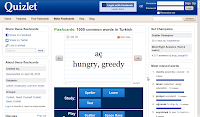
If you scroll down the page, there's an option to Export the deck:
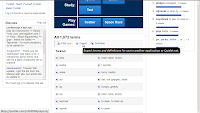
I clicked on that, which took me to:
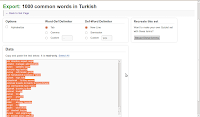
I made sure that "Tab" and "New Line" were selected as the delimiters, then copied and pasted the contents into a text editor. I'm using Ubuntu on my PC, so I just used GEdit, but any editor will do. I then just saved the text file as a normal .txt file.
Next, I opened up Anki and clicked on "Import" (disregard the number of reviews due - a clue of how often I use Anki, I guess.) Once you click on "Import", you're prompted for a name to use to create the new deck:
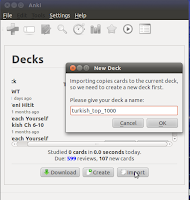
Then, I clicked on the "Import" button for Field 1 on the Import screen:
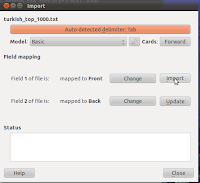
If all goes well, you'll get a Status dialog telling you the import is complete:
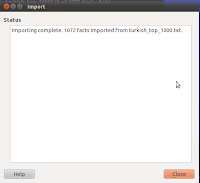
And that's it! Now the deck is usable in Anki and can be synced to AnkiWeb, then transferred to your smartphone or tablet Anki application.
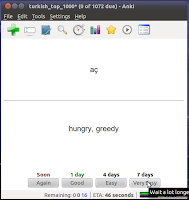
There were quite a few decks I saw on Quizlet that interested me, so I'll probably be back to check them out. I might also look at some of the other things they do on the site. The social aspect and some of the "competitive study" games look interesting.
Part of the reason I've been so busy with work is because I've been asked to create an online language course for ESL learners. That's the subject for another post, but it's a very involved project and one that I'm very excited about.
Anyway, one of the tasks in this ESL course project was to create a sort of online flashcard-type quiz. In my research, I discovered Quizlet.com. I'm not a huge fan of flashcards, although I do use them in my "wasted minutes" throughout the day. But I use Anki for that, personally. I'm not really one to sit in front of my computer with flashcards. I have no problem using them when on the go or on my tablet, though.
While poking around the site, I found some pretty good decks that I could use myself. It seems the quality of the decks vary because anyone can create them, I suppose. So it pays to really look at what's there.
I'll go through what I did to get a deck from Quizlet into Anki in this post. It's easy, but manual.
First, I found a deck I wanted to use - I chose a deck called "1000 common words in Turkish":

If you scroll down the page, there's an option to Export the deck:

I clicked on that, which took me to:

I made sure that "Tab" and "New Line" were selected as the delimiters, then copied and pasted the contents into a text editor. I'm using Ubuntu on my PC, so I just used GEdit, but any editor will do. I then just saved the text file as a normal .txt file.
Next, I opened up Anki and clicked on "Import" (disregard the number of reviews due - a clue of how often I use Anki, I guess.) Once you click on "Import", you're prompted for a name to use to create the new deck:

Then, I clicked on the "Import" button for Field 1 on the Import screen:

If all goes well, you'll get a Status dialog telling you the import is complete:

And that's it! Now the deck is usable in Anki and can be synced to AnkiWeb, then transferred to your smartphone or tablet Anki application.

There were quite a few decks I saw on Quizlet that interested me, so I'll probably be back to check them out. I might also look at some of the other things they do on the site. The social aspect and some of the "competitive study" games look interesting.
Subscribe to:
Comments (Atom)
